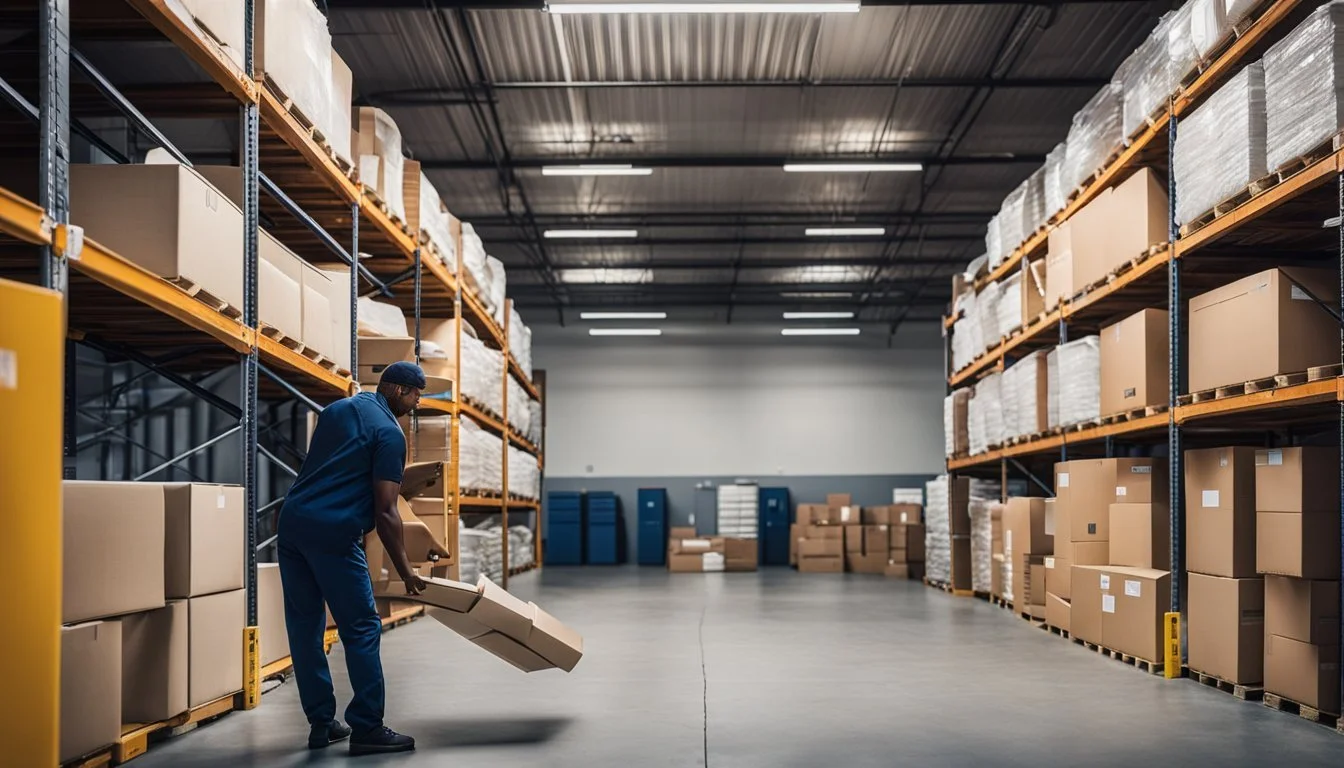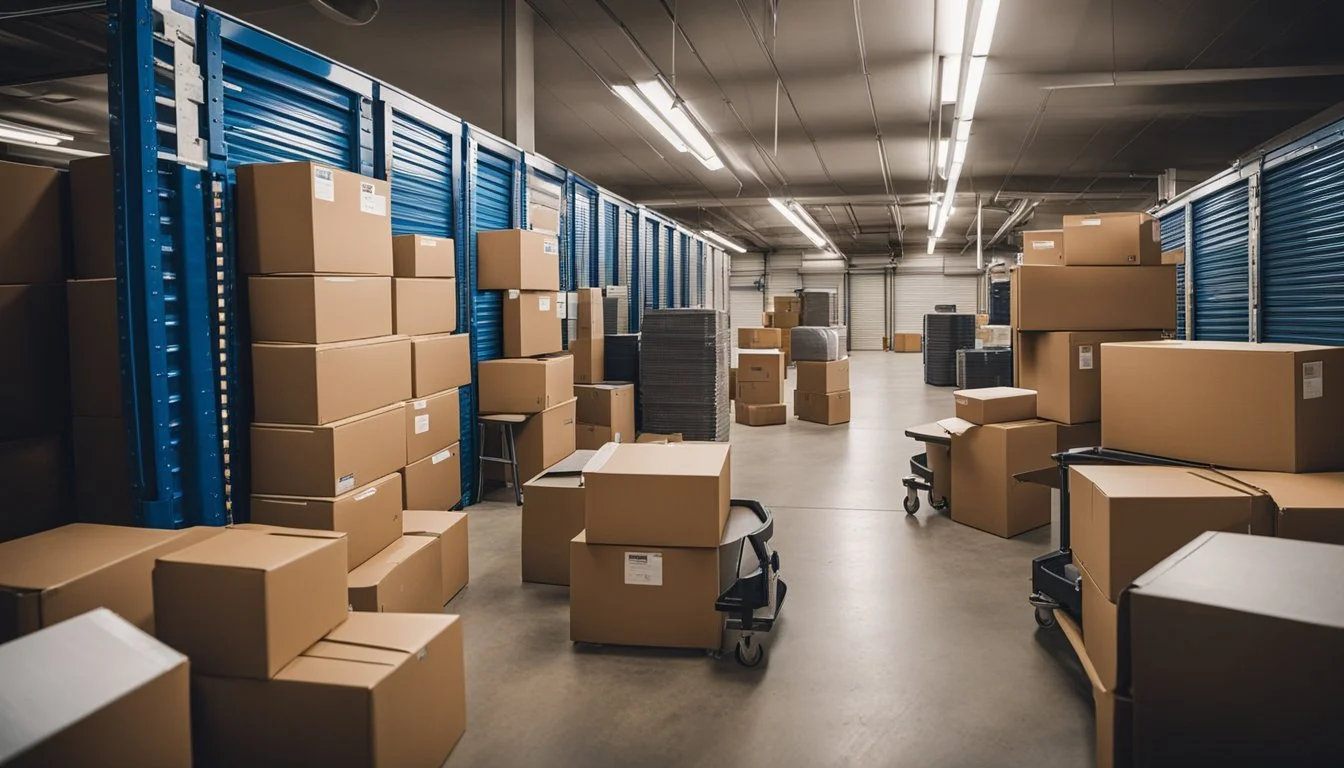Moving to Austin: Finding the Best Storage Units for Your Needs
Moving to Austin can be an exciting yet challenging experience, especially when it comes to managing your belongings. Whether you're downsizing, in need of temporary storage, or simply looking to keep some items safe during the transition, Austin offers a range of storage solutions to fit every need and budget.
The average cost for a 10'x10' storage unit in Austin is $113 per month, with prices starting as low as $5 for smaller lockers and going up to $1,500 for larger units. Facilities like Life Storage, Extra Space Storage, and Burnet Road Self Storage provide versatile options, including climate-controlled units and advanced security features to ensure your belongings are well-protected.
In Austin, you can find storage units that cater to various needs whether it’s for short-term or long-term use. Options like drive-up access, elevators, and electric gates make the moving process easier and more convenient, ensuring a smooth transition to your new home. By choosing the right storage solution, you can focus on settling into the vibrant life that Austin has to offer without worrying about your possessions.
Understanding Storage Solutions in Austin
When moving to Austin, finding the right storage solution is crucial. There are different types of storage units available, each with unique benefits. Additionally, climate-controlled units offer protection for sensitive items, and selecting the right size and accessibility options can make all the difference.
Various Types of Storage Units
In Austin, there are several types of storage units to consider. Traditional self-storage units are the most common and can be found throughout the city. These units provide a secure space for a variety of items ranging from household goods to business inventory.
Portable storage containers, like those provided by PODS, offer flexibility. These containers can be delivered to your location, allowing you to load and unload at your convenience.
For those who need short-term storage during a move, some facilities offer temporary storage solutions. This option is particularly useful for those who require storage for a few days to a few weeks.
Benefits of Climate-Controlled Units
Climate-controlled units are essential for protecting sensitive items from Austin’s temperature fluctuations. Electronics, wooden furniture, and certain types of artwork can suffer damage if not stored in a controlled environment. These units maintain a consistent temperature and humidity level year-round.
Additionally, climate-controlled storage is beneficial for storing documents and photographs. Paper items can become brittle or moldy if exposed to excessive heat or moisture, making climate control indispensable for preserving these items.
Choosing a climate-controlled unit ensures that your belongings are safe from the extreme weather conditions common in Austin.
Considering Size and Accessibility of Storage Units
Selecting the right unit size is important for efficient storage. Storage facilities in Austin offer a variety of unit sizes, from small lockers to large rooms. Determine the amount of space you need by taking inventory of your items before choosing a unit.
Accessibility is another key factor. Some facilities offer 24-hour access, which can be convenient if you need to retrieve items outside of regular business hours. Others may have limited access hours but provide enhanced security.
When considering accessibility, also think about the facility’s location. Opting for a storage unit closer to your home or work can save time and make the process more convenient.
Evaluating Storage Facilities and Amenities
When evaluating storage options in Austin, it's crucial to consider the security measures, additional amenities, and the significance of the facility's location.
Security Features to Consider
Security is a critical aspect of any storage facility. Customers should look for 24/7 surveillance cameras to ensure constant monitoring of the premises.
Secure access systems like gate codes or keycards add another layer of protection. Fenced perimeters and well-lit areas help deter unauthorized access, while individual unit alarms provide peace of mind.
On-site management presence can further enhance security by addressing issues promptly.
Additional Amenities Offered
Different storage facilities offer a range of amenities that can make storing belongings more convenient.
Climate-controlled units are essential for protecting sensitive items from extreme temperatures and humidity. Drive-up access allows for easier loading and unloading, saving time and effort.
Some facilities offer free use of moving trucks, reducing the cost and hassle of transportation. Look for locations that provide packing supplies on-site for added convenience.
The Importance of Location
The location of a storage facility plays a significant role in its accessibility and convenience. Ideally, the facility should be close to your home or office to minimize travel time.
Access to major roads and highways can also impact ease of use, particularly during a move. Consider the surrounding area's safety, as a well-located, secure neighborhood adds an extra layer of protection for stored items.
Lastly, proximity to essential services and businesses can add to the facility's convenience.
Cost Considerations
When moving to Austin, considering the cost of storage units is crucial. This includes not just the monthly rental fee but also additional expenses such as insurance and potential hidden costs.
Understanding Storage Costs
Storage unit prices in Austin vary based on several factors. The location of the facility plays a significant role; units closer to the city center or university areas, like the University of Texas, tend to be more expensive. Additionally, the size of the unit impacts the cost. A 10'x10' unit averages around $113 per month.
Amenities also affect costs. Units with climate control, electrical outlets, or 24/7 access are priced higher. The cost can range from as low as $5 for small lockers to $1,500 for larger units with multiple amenities. Seasonal demand can influence prices too, with peaks typically around the start of the academic year.
Budgeting for Your Storage Unit
Creating a budget for your storage unit is essential. Start by listing all potential costs. Besides the basic rent, factor in insurance, which can range from $10 to $30 monthly. Some facilities might charge an administration fee, so it's important to inquire about any additional charges upfront.
Also, consider long-term discounts or promotions. For instance, some services offer deals like a percentage off for the first few months. Calculate the total annual cost to get a clear picture. Reckoning these factors will help in selecting a unit that fits both your needs and your wallet.
Preparation and Packing Strategies
When preparing to move to Austin, having well-thought-out packing and loading strategies will ensure a smooth transition. This section focuses on the best practices for packing, tips for loading and unloading, and guidance on transporting items to storage units.
Best Practices for Packing Your Belongings
Begin packing early to avoid last-minute stress. Use sturdy boxes and quality packing materials like bubble wrap, packing peanuts, and tape. Label each box clearly with its contents and destination room to streamline unpacking.
For fragile items, wrap each piece individually and fill any gaps in the box with padding to prevent movement. Disassemble large furniture, and keep screws and small parts in labeled bags. Arrange heavy items at the bottom of boxes and lighter items on top to prevent damage.
Loading and Unloading Tips
When loading the moving truck, distribute weight evenly to maintain balance during transport. Start with heavier items like appliances and large furniture, placing them against the truck’s walls for stability. Use moving straps and blankets to secure items and prevent scratches.
Create an aisle down the center of the truck for easy access to all items. Stack lighter, smaller boxes on top of heavier ones but avoid stacking too high to prevent tipping. During unloading, take breaks to avoid fatigue and handle items carefully to prevent injuries.
Transporting Items to the Storage Unit
Before transporting your belongings to the storage unit, ensure the unit is clean and free of any pests. Pack items you’ll need most frequently at the front of the unit for easy access.
Use shelving to maximize space and keep items organized. When stacking boxes, place the heaviest ones at the bottom and lighter ones on top. For optimal security, use high-quality locks and consider a climate-controlled unit to protect sensitive items from temperature changes. Make sure the pathway to the storage unit is clear and accessible to ease the unloading process.
Specialized Storage Options
When moving to Austin and looking for storage, it's vital to know about specialized options available. Different items require specific types of storage to ensure they remain safe and secure.
Vehicle and Boat Storage Solutions
Austin has numerous facilities providing vehicle and boat storage solutions. These specialized storage units offer a secure environment for boats, RVs, and other large vehicles.
Common features include:
24/7 security monitoring
Covered and uncovered spaces
Drive-up access for easy parking and retrieval
Facilities like Life Storage and Oak Hill Mini’s Self Storage provide these amenities in various sizes, from small lots to large spaces for luxury boats.
Storing Sensitive Items like Electronics and Instruments
Sensitive items such as electronics and musical instruments need climate-controlled units to protect them from temperature and humidity fluctuations. Extra Space Storage in Austin offers climate-controlled options suitable for delicate items.
Key aspects to consider:
Temperature regulation to prevent overheating or freezing
Humidity control to avoid moisture build-up
Security measures like surveillance and restricted access
Choosing the right storage ensures these items remain in perfect condition.
Finding the Right Unit for Large or Unconventional Items
Storing large or unconventional items can be tricky, but facilities in Austin provide various options. Units range from small 5'x5' spaces to expansive 10'x20' areas.
When selecting a unit for large items:
Measure your items to know the exact space needed
Look for drive-up access for easier loading and unloading
Check the facility's policies on oversized or heavy items
Oak Hill Mini's Self Storage, for instance, offers diverse unit sizes and drive-up access, catering to various storage needs.
Choosing the Right Storage for Your Need
Selecting the ideal storage unit involves understanding the duration of storage, assessing various service options, and considering customer feedback. The following subsections will break down these key factors in detail.
Short-Term Vs. Long-Term Storage
Short-term storage is ideal for temporary needs like moving between homes or storing belongings during renovations. These units typically offer flexible rental agreements with month-to-month leases.
Long-term storage, on the other hand, often comes with discounted rates for extended contracts and is suited for storing items that won't be needed for several months or years, such as seasonal equipment or archived business records. Choosing between short-term and long-term largely depends on personal or business requirements.
Comparing Self-Storage and Full-Service Options
Self-storage units provide the convenience of personal access to belongings. Customers handle packing, transport, and organizing their storage spaces. Facilities like Public Storage and Life Storage offer various unit sizes and amenities like climate control and drive-up access.
Full-service storage companies take care of the packing, transport, and storage for you. This option is particularly beneficial for those with limited time or physical ability to move heavy items. Although full-service may come at a higher cost, it provides ease and efficiency.
The Role of Customer Reviews in Making a Choice
Customer reviews can significantly affect one's decision. Checking reviews on platforms like ConsumerAffairs gives insights into others' experiences with customer service, facility cleanliness, and security.
Positive reviews often highlight efficient customer service and safe, well-maintained facilities. Conversely, negative reviews can flag potential issues like hidden fees or poor security. Paying attention to both the quantity and quality of reviews can guide you to the most reliable storage options.
By carefully considering these aspects, individuals and businesses can ensure they select the best storage unit for their unique needs.
Special Considerations for Different User Groups
Different users have specific needs when it comes to selecting the best storage units in Austin, whether it's for college students, homeowners, renters, or businesses needing extra space.
Storage for College Students and Seasonal Users
College students in Austin often require short-term storage solutions, particularly during summer breaks. Facilities such as Extra Space Storage on Slaughter Creek Drive offer flexible rental durations suitable for this group.
Popular unit sizes include 5'x5' or 5'x10', which are ideal for storing dorm room items, textbooks, and small furniture.
Key considerations for college students:
Proximity: Storage units close to campuses like the University of Texas-Austin.
Cost-effectiveness: Discounts or promotions specifically for students.
Security: Enhanced security measures to protect valuable belongings.
Solutions for Homeowners and Renters During Moving or Renovating
Homeowners and renters in Austin often seek storage units during moving or renovation projects. Life Storage on South Congress Ave and Oak Hill Mini's Self Storage provide a variety of unit sizes, such as 10'x10' to 10'x20', to accommodate larger household items, furniture, and appliances.
For homeowners and renters, key considerations include:
Accessibility: Easy drive-up access for larger items.
Size Variety: Options to choose the right size for their needs.
Climate Control: Protecting sensitive items like wood furniture and electronics.
Business Storage Solutions for Documents and Inventory
Businesses in Austin may require storage units for documents, inventory, and equipment. Facilities like Extra Space Storage offer climate-controlled units which are beneficial for storing important documents and sensitive merchandise.
For businesses, key considerations are:
Unit Size: Options to store varying volumes of inventory and supplies.
Climate Control: Protecting business documents and electronic equipment.
Location: Proximity to business premises for easy and quick access.
Businesses, whether small retailers or large enterprises, can benefit from these facilities in maintaining an organized workspace by storing excess inventory and archived documents.
Legal and Insurance Aspects
It's essential to address legal and insurance considerations when storing items in Austin. Understanding insurance coverage and being aware of rental agreements are crucial for protecting personal belongings and ensuring compliance with policies.
Understanding Insurance Options for Stored Items
Insurance for stored items provides protection against unforeseen events such as theft, fire, and water damage.
Many storage facilities in Austin offer insurance as an add-on service. Customers can purchase policies tailored to the value of their belongings. It’s advisable to carefully review coverage options to choose the best plan.
Some renters might find their homeowner's or renter's insurance already covers stored items.
However, it’s crucial to verify specific coverage limits and perils included.
Moreover, it’s wise to document the condition of items and keep an inventory list, which can be instrumental when filing claims. Utilizing robust locks and opting for climate-controlled units can further safeguard against damage.
Rental Agreement and Storage Policies
Rental agreements outline the terms and conditions for using storage facilities.
They typically include details about rental periods, payment terms, and late fees. Storage units in Austin may require a minimum rental period, which can range from month-to-month to longer terms.
Reading the fine print of the rental agreement helps avoid surprises.
Policies on access hours, security measures, and responsibilities of both the renter and the facility are usually highlighted. It is also important to understand restrictions on stored items — certain units may prohibit storing hazardous materials or perishables.
Before signing, renters should clarify cancellation policies and potential penalties. Reviewing these aspects ensures a smooth rental experience and legal compliance.
Local Insights
When moving to Austin, selecting the best storage unit involves understanding the different neighborhoods and nearby areas. By doing so, you can simplify your moving process and ensure your belongings are stored safely and conveniently.
Exploring Neighborhoods: Downtown Austin and Beyond
Downtown Austin offers a variety of storage options that cater to the busy lifestyle of the city's urban residents. Proximity to major landmarks like the University of Texas makes these units ideal for students and faculty.
Storage facilities in this area often feature conveniences such as 24/7 access and climate-controlled units.
Beyond Downtown, areas like South Congress and East Austin are notable for their unique storage solutions. These neighborhoods offer a mix of modern and traditional options, making it easy to find a unit that matches your specific requirements.
Choosing Storage in Surrounding Areas like Round Rock and Pflugerville
Round Rock and Pflugerville, located just north of Austin, provide excellent storage alternatives, especially for those residing in suburban areas. These locations usually offer more spacious units at competitive rates compared to the city center.
Facilities in Round Rock often include amenities like electric gates and security cameras, enhancing safety.
Pflugerville's storage units are known for their convenient drive-up access, making loading and unloading a breeze. The abundance of options in these areas ensures that you can find the right storage solution, whether you need something temporary during a move or a longer-term arrangement.






